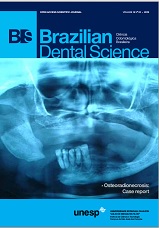Osteoclacin expression during autogenous onlay bone grafts with or without resorbable collagen membrane in diabetic rats
DOI:
https://doi.org/10.14295/bds.2015.v18i2.1089Resumo
Objective: This study aimed to quantify through immunohistochemistry the expression of bone formation marker osteocalcin during the repair process of autogenous onlay bone graft, associated or not to the resorbable collagen membrane and to compare these findings with the presence of Diabetes Mellitus. Material and Methods: Sixty rats (Rattus norvegicus, albinus variation, Wistar) aged 90 days, were divided into two groups with 30 animals: test group – rats with induced diabetes; control group - normoglycemic rats. All rats received grafts on the left and right hemi-mandible with or without collagen membrane coverage, respectively. The animals were euthanized at the following periods: 0h, 7, 14, 21, 45, and 60 days. Immunohistochemistry analysis was performed by the marker osteocalcin at receptor site-graft interface. To analyze osteocalcin immunohistochemical expression, a panoramic view photograph of the graft was taken followed by two photographs at larger magnification. Results: No statistically significances at 5% level were observed between diabetic and control group with and without membrane; and diabetic and control groups with membrane coverage. Conclusion: Within the limits of this present study, it can be concluded that the osteocalcin marker might be influenced by diabetes so that it was late expressed during this condition. However, the association of the graft with the membrane could improve this delay by reaching expression values similar to those of control group.
Downloads
Downloads
Arquivos adicionais
Publicado
Como Citar
Edição
Seção
Licença
TRANSFERÊNCIA DE DIREITOS AUTORAIS E DECLARAÇÃO DE RESPONSABILIDADE
Toda a propriedade de direitos autorais do artigo "____________________________________________________________________" é transferido do autor(es) para a CIÊNCIA ODONTOLÓGICA BRASILEIRA, no caso do trabalho ser publicado. O artigo não foi publicado em outro lugar e não foi submetido simultaneamente para publicação em outra revista.
Vimos por meio deste, atestar que trabalho é original e não apresenta dados manipulados, fraude ou plágio. Fizemos contribuição científica significativa para o estudo e estamos cientes dos dados apresentados e de acordo com a versão final do artigo. Assumimos total responsabilidade pelos aspectos éticos do estudo.
Este texto deve ser impresso e assinado por todos os autores. A versão digitalizada deverá ser apresentada como arquivo suplementar durante o processo de submissão.




























